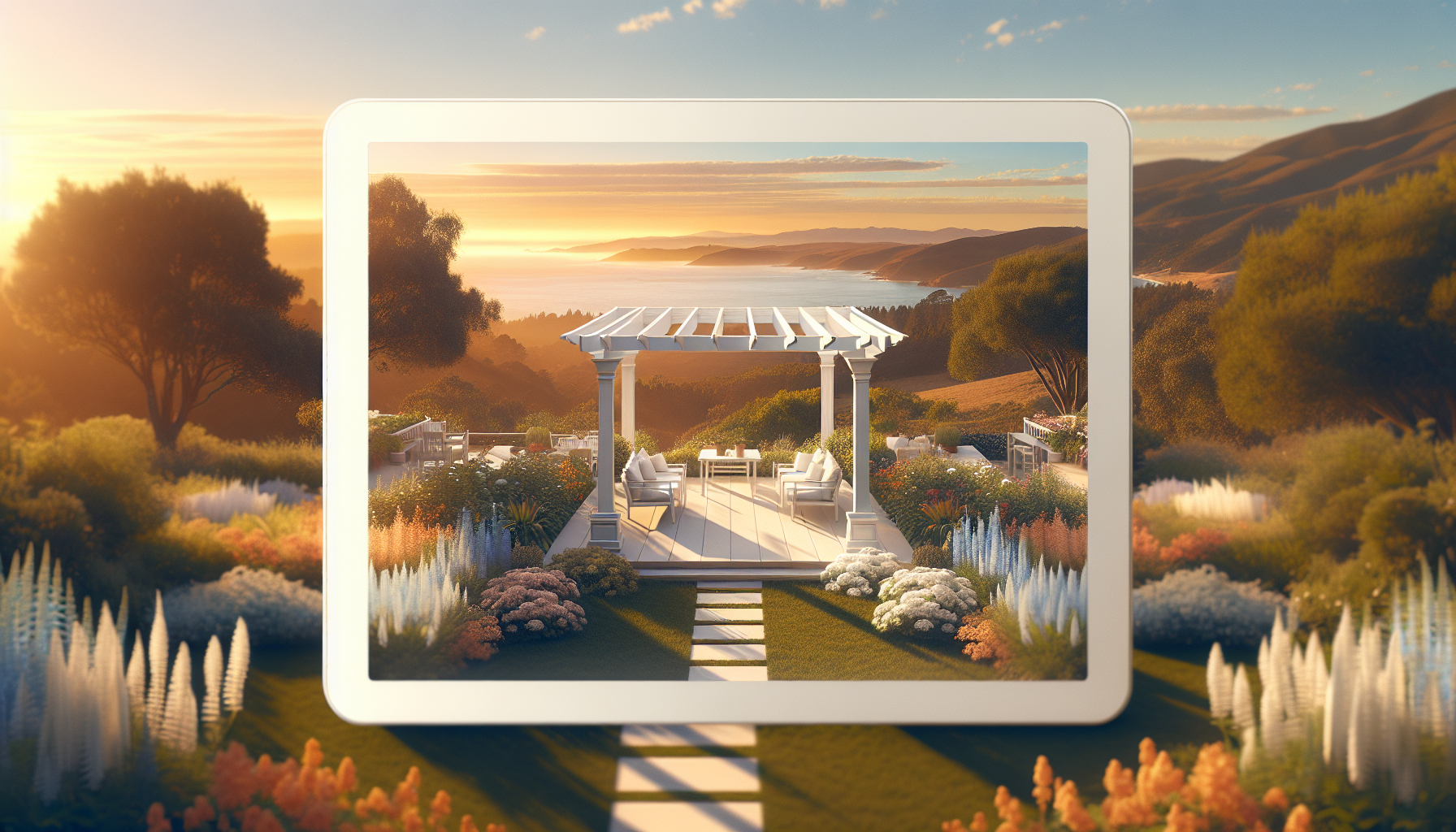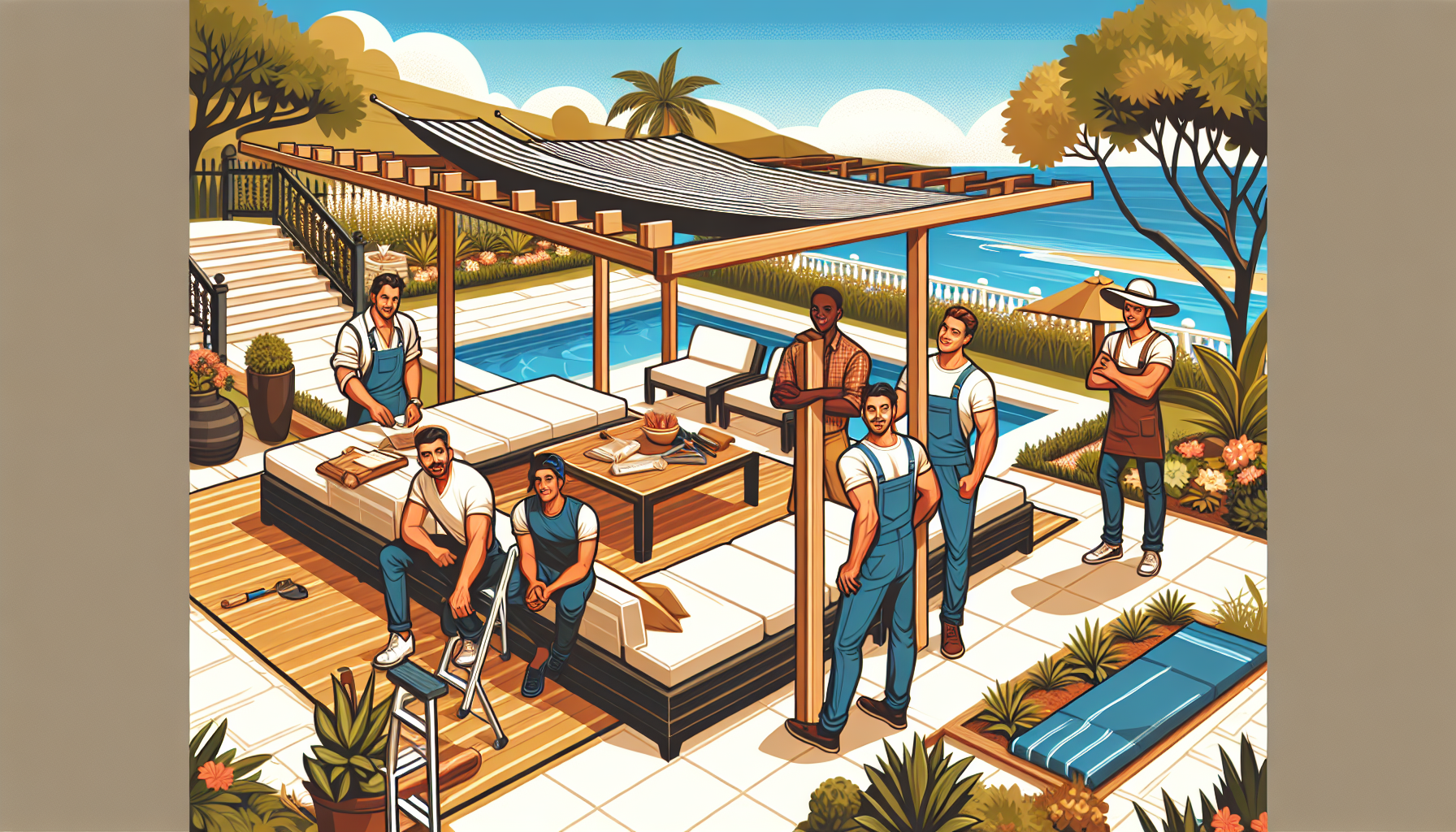Understanding the Basics: What Are Pergolas and Patios?
When diving into outdoor living spaces, two terms often surface, frequently causing a mix-up for many homeowners: pergolas and patios. While both are essential in landscaping and outdoor design, they serve distinct purposes and offer unique benefits for your home’s exterior. A pergola is an outdoor structure, typically consisting of columns that support a roofing grid of beams and rafters. This grid may be left open or covered to create an area sheltered from the direct sun while allowing airflow.
On the other hand, a patio is a paved outdoor area adjoining a house, generally used for dining or leisure. Unlike pergolas, patios are usually at ground level and can be constructed using various materials, including concrete, stone, pavers, and brick. While a pergola is more about vertical space and can be freestanding or attached to your home, a patio is decidedly a horizontal structure, providing a foundation for outdoor living.
It’s imperative to recognize that choosing between a pergola and a patio is aesthetic and functional. If your vision for your outdoor space includes climbing plants or hanging vines, a pergola might be the perfect fit, offering a lattice upon which greenery can thrive. However, suppose you envision a space for outdoor dining, sunbathing, or a safe play area for children. In that case, a patio provides a level and solid surface that suits these activities well. The customization possibilities for both are plentiful, allowing homeowners to match their outdoor structures to their homes’ existing theme and architecture.
Deciphering the characteristics of pergolas versus patios is just the first step in creating an outdoor space that aligns with your lifestyle. Understanding their structural differences is key in deciding which will best meet the needs of your outdoor living goals. With their open structure, Pergolas cater to those who prefer a mix of sun and shade, along with a touch of nature interwoven into the design. Conversely, patios cater to those who prioritize a flat, durable surface that seamlessly extends the living space from the indoors to the outdoors.
Design Ideas for Combining Pergolas and Patios
Transforming your outdoor space into a stunning and functional retreat involves merging comfort with style. Combining pergolas with patios can introduce a versatile blend of shade and openness that accommodates a variety of outdoor activities. Here are some inspired design ideas to enrich backyard aesthetics while crafting the perfect leisure spot.
Harmonious Material Selection
Choosing materials that complement your home’s facade and the natural landscape ensures a seamless integration of your pergola-patio combination. Consider natural woods like cedar or redwood that gracefully age with your garden for a rustic charm. If a more modern appeal suits your taste, combining sleek metal or vinyl structures with pavers or polished concrete for the patio can create a contemporary sanctuary. Emphasize longevity and maintenance in your material choices to ensure that your outdoor space remains a timeless luxury.
Strategic Positioning for Optimal Enjoyment
The location of your pergola within the patio layout is crucial for maximizing comfort. Position your pergola to provide ample shade during the hottest parts of the day without compromising on the view from inside your home. An east-west alignment allows for soft morning light while offering protection against the harsh afternoon sun. Incorporating retractable canopies or drapes adds flexibility, enabling you to adjust the levels of shade and privacy as desired.
Blending Functionality with Aesthetics
A pergola-patio ensemble should be as functional as it is attractive. Integrate built-in seating or space for outdoor furniture to encourage relaxation and socialization. Climbing plants or hanging baskets can introduce a touch of greenery, softening the architectural lines and providing a refreshing ambience. For evening entertainment, integrate lighting elements—such as string lights or recessed LED fixtures—to create a warm and inviting glow. By infusing these practical features into your design, you craft a space that is beautiful and fully attuned to your entertainment and relaxation needs.
Maximizing Your Outdoor Experience with Pergolas and Patios
Pergolas and patios play pivotal roles that extend beyond mere aesthetics in the quest to create the ultimate backyard oasis. These structures provide practical solutions to common outdoor living challenges while enhancing the overall usability of your garden or yard space. Embracing the functionality of pergolas and patios not only elevates your outdoor experience but also adds to the value of your property. Whether it’s a sunny afternoon or a cool evening, these features can transform your engagement with the outdoors.
Pergolas serve as a stylish centerpiece in garden design, providing ambience and comfort that can make your backyard feel like another room of your home. With their slatted roofs, pergolas offer a balance of light and shade, making them perfect for everything from al fresco dining to a peaceful retreat for reading or meditation. Integrating climbing plants adds a natural element that can bring shade and a burst of colour to your patio area. Moreover, their open design ensures a continuous breeze, making hot summer days more enjoyable. As a versatile structure, pergolas can be customized to fit any size of a garden or designed to match the aesthetic of your home.
When it comes to patios, the options for customization and style are equally diverse. The foundation of many outdoor living spaces, patios can be crafted from various materials including concrete, pavers, stone, or brick. This allows homeowners to create a space that reflects their style and complements the natural surroundings. Patios act as the ultimate stage for various outdoor activities, from hosting family gatherings to quiet morning coffee rituals. Not only do they provide a stable, low-maintenance platform for furniture and outdoor décor, but they also define the living space and help create a seamless indoor and outdoor flow.
Integrating a pergola and a patio into your landscape design ensures you can enjoy your outdoor area regardless of the weather. Consider installing a retractable canopy on your pergola for added versatility, allowing you to control the amount of sun exposure on your patio. Adding soft lighting can extend the hours of enjoyment, creating an inviting atmosphere long after the sun has set.
Maintenance Tips to Keep Your Pergola and Patio Looking Great
Ensuring your pergola and patio remain in tip-top condition extends their longevity and elevates your outdoor space’s aesthetics. Regular maintenance is key to preventing wear and tear from the elements. One essential step is to perform a thorough inspection at the beginning and end of each season. Look for signs of damage or wear in the wood or metal, such as splintering, rust, or peeling paint. Addressing these issues early can save you from expensive repairs down the line.
Cleaning is also vital in maintaining the appearance and durability of your pergola and patio. For wood structures, a soft brush and a mild soap solution can remove dirt and grime without damaging the material. If algae or mildew is present, a solution of water and vinegar works effectively as a gentle yet powerful cleaning agent. Regular sweeping to remove debris and periodic pressure washing can prevent surface deterioration and staining for patios.
To further protect your pergola and patio, consider applying a sealant or stain suited for your structures’ particular materials. Sealants provide a layer of protection against water damage and UV rays and enhance the natural beauty of wood grains. Reapplication of sealant is recommended every two to three years or according to the product’s specific instructions. Pay special attention to any joints or areas where water might collect to prevent rot and decay.
Upholding furniture and accessories complementing your pergola and patio is just as important. Cushions and pillows should be stored away or covered during inclement weather, and outdoor furniture should be cleaned according to manufacturer recommendations. This will keep your outdoor living space inviting and ready for entertaining or personal enjoyment throughout the year.
How to Choose the Right Materials for Your Pergola and Patio
When it comes time to select materials for your pergola and patio, several factors must be considered that will impact not just the aesthetics but also the longevity and maintenance requirements of your outdoor space. Your choice of materials should harmonize with the local climate, match the style of your home, and align with your personal preferences for maintenance and durability. Understanding the unique characteristics of various materials will empower you to make informed decisions that bring your vision of a comfortable and stylish outdoor living space to life.
Determining the Best Wood for Durability and Style
Wood brings a classic, natural beauty to outdoor structures and can be tailored to fit a wide range of styles, from rustic to refined. When choosing lumber for your pergola and patio, hardwoods like cedar, redwood, and pressure-treated pine are popular due to their natural resistance to rot and insects. Cedar and redwood also benefit from weathering to an attractive silver-gray patina if left untreated. However, consider the weather in your area—humid climates might require more frequent sealing or staining to preserve the wood’s integrity and appearance.
Exploring Low-Maintenance and Durable Options
For those seeking a more low-maintenance solution, materials like composite and PVC offer the appearance of wood without the need for regular upkeep. These materials are manufactured to resist fading, staining, and warping, significantly reducing the labor and cost of long-term maintenance. Additionally, composites can be found in a wide selection of colors and textures, allowing for a high degree of customization for your outdoor space. While the initial investment may be higher than natural wood, the longevity and reduced upkeep often justify the cost for homeowners who prioritize ease of care.
Considering Stone and Concrete for a Sturdy Grounding
Patio foundations demand a material that can withstand foot traffic, furniture, and the elements. Choosing the right base for your patio is crucial and often involves materials like stone and concrete. The stone’s natural charm provides a unique and elegant look, with options like bluestone, slate, or limestone. Each stone type has its distinct hues and textures, allowing it to complement the style of your garden and home exterior. Concrete, on the other hand, offers a more uniform appearance and can also be stamped or dyed for added visual interest. Both stone and concrete slab patios require proper installation to ensure levels are correct and adequate drainage, preventing water accumulation and potential damage.




